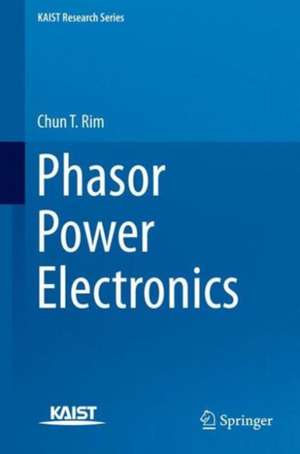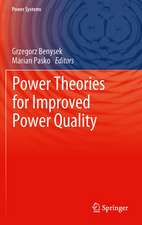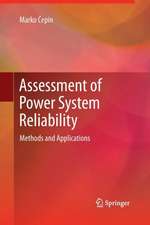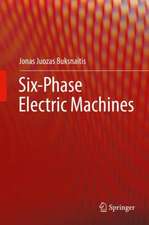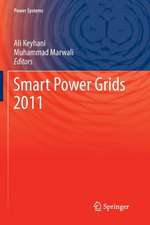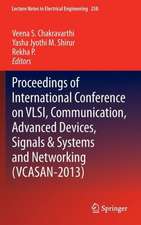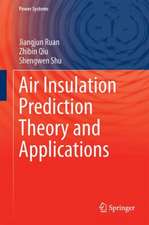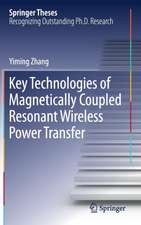Phasor Power Electronics: KAIST Research Series
Autor Chun T. Rimen Limba Engleză Hardback – 11 apr 2016
The book starts with an introduction to the philosophy and fundamental principles of power electronics. The switched transformer concept, which is applicable to any switching converter, is introduced, and it is shown how DC-DC converters analyses are then so straightforward that very little equational manipulation is needed. Then the phasor transformation techniques are comprehensively explained over three parts. Single phase and multi-phase AC systems are dealt with through the single phase phasor transformation and circuit DQ transformation, respectively. A general unified phasor transformation is then introduced for the static and dynamic cases. The final part of the book considers current and potential extensions of the technique in various fields of application, including wireless power transfer, signal processing, power systems and renewable energy.
The book avoids the piece-wise linear circuit models used in other titles, with which the mathematical results become too complicated to be used in practice. No cumbersome equations or matrix manipulations are needed with the phasor transformation techniques introduced in this book. It will be a valuable reference source for engineering students and practising researchers in power electronics and related areas.
| Toate formatele și edițiile | Preț | Express |
|---|---|---|
| Paperback (1) | 781.07 lei 39-44 zile | |
| Springer Nature Singapore – 25 apr 2018 | 781.07 lei 39-44 zile | |
| Hardback (1) | 952.89 lei 3-5 săpt. | |
| Springer Nature Singapore – 11 apr 2016 | 952.89 lei 3-5 săpt. |
Preț: 952.89 lei
Preț vechi: 1162.06 lei
-18% Nou
Puncte Express: 1429
Preț estimativ în valută:
182.34€ • 194.98$ • 152.03£
182.34€ • 194.98$ • 152.03£
Carte disponibilă
Livrare economică 27 martie-10 aprilie
Preluare comenzi: 021 569.72.76
Specificații
ISBN-13: 9789811005350
ISBN-10: 9811005354
Pagini: 249
Ilustrații: XIV, 249 p. 193 illus., 54 illus. in color.
Dimensiuni: 155 x 235 x 19 mm
Greutate: 0.66 kg
Ediția:1st ed. 2016
Editura: Springer Nature Singapore
Colecția Springer
Seria KAIST Research Series
Locul publicării:Singapore, Singapore
ISBN-10: 9811005354
Pagini: 249
Ilustrații: XIV, 249 p. 193 illus., 54 illus. in color.
Dimensiuni: 155 x 235 x 19 mm
Greutate: 0.66 kg
Ediția:1st ed. 2016
Editura: Springer Nature Singapore
Colecția Springer
Seria KAIST Research Series
Locul publicării:Singapore, Singapore
Cuprins
I Introduction to Power Electronics.- 1 The Philosophy of Power Electronics.- 2 Key Principles of Power Converters.- II Switching Converters as Electronic Transformers.- 1 State Space Average Model and Existence Function Model.- 2 Equational Models vs. Circuit Models.- 3 Switched Transformer Model and Averaged Transformer Model. 4 DC Analyses, AC Analyses, and Harmonic Analyses.- III Single Phase AC circuits and Resonant Converters.- 1 Basic Phasor Transformation.- 2 Application to Series Resonant Converters.- 3 Application to AC circuits and Phasor Detectors.- IV Multi-Phase AC circuits and Circuit DQ-Transformation.- 1 Circuit DQ-Transformation.- 2 Application to Current Source Inverter.- 3 Quantum Transformations.- V Unified General Phasor Transformation.- 1 Static Phasor Transformation.- 2 Laplace Phasor Transformation.- 3 Dynamics Characterization of Inductive Power Transfer Systems by Laplace Phasor Transform.- 4 General Phasor Transformers for Non-ideal Switching Converters.-VI Phasored Power Electronics and Beyond.- 1 Phasored Wireless Power Transfer.- 2 Phasored Filters.- 3 Complex Controllers and Phasored Signal Processing.- 4 Phasored Motors.- 5 Phasored Power Systems and Renewable Energies.- 6 Phasored Mechanics, Musical Instruments, and Quantum Mechanics.- VII Conclusions.- 1 Phasor Transformers in Power Electronics.- 2 The Futures of Power Electronics.
Recenzii
Notă biografică
Chun T. Rim received the B.S. degree with Honor in electrical engineering from KIT in 1985, and the M.S. and Ph.D. degrees in electrical engineering from KAIST, Korea, in 1987 and 1990, respectively.
Since 2007, he has been an associate professor of Nuclear and Quantum Engineering at KAIST. He has been developing various wireless power technologies including inductive power transfer systems for On-Line Electrical Vehicles. From 1990 to 1995, he was a military officer at the Ministry of National Defense in Korea. From 1995 to 2003, he was a senior researcher at the Agency for Defense Development, Daejeon, and from 1997 to 1999, he was with Astrium in Portsmouth, U.K. From 2003 to 2007, he was a senior director at the Presidential Office, Seoul, Korea. He was involved in developing Korea’s first airborne and spaceborne synthetic aperture radars. His research areas include wireless electric vehicles, wireless power systems for robots, mobiles, wearables and IoT, andgeneral unified modeling of power electronics. He has authored or coauthored 142 technical papers, written eight books, and holds 141 patents (awarded and pending). He won numerous awards including the Best Paper Award of IEEE Power Electronics Transactions in 2015 (wireless power) and three prizes by the Korean government. He was the chair of Wireless Power Committee of KIPE from 2010 to 2015 and the chair of EV Charger Committee of KIEE since 2011, respectively.
He is now an associate editor of IEEE Transactions on Power Electronics and the Journal of Emerging and Selected Topics in Power Electronics (J-ESTPE), a guest editor of the Special Issue on Wireless Power Transfer of the IEEE Transactions on Power Electronics, IEEE Transactions on Industrial Electronics, and J-ESTPE, and the general chair of the 2014 IEEE VTC-Workshop on Wireless power (WoW), 2015 IEEE WoW, and 2016 IEEE WoW.
Since 2007, he has been an associate professor of Nuclear and Quantum Engineering at KAIST. He has been developing various wireless power technologies including inductive power transfer systems for On-Line Electrical Vehicles. From 1990 to 1995, he was a military officer at the Ministry of National Defense in Korea. From 1995 to 2003, he was a senior researcher at the Agency for Defense Development, Daejeon, and from 1997 to 1999, he was with Astrium in Portsmouth, U.K. From 2003 to 2007, he was a senior director at the Presidential Office, Seoul, Korea. He was involved in developing Korea’s first airborne and spaceborne synthetic aperture radars. His research areas include wireless electric vehicles, wireless power systems for robots, mobiles, wearables and IoT, andgeneral unified modeling of power electronics. He has authored or coauthored 142 technical papers, written eight books, and holds 141 patents (awarded and pending). He won numerous awards including the Best Paper Award of IEEE Power Electronics Transactions in 2015 (wireless power) and three prizes by the Korean government. He was the chair of Wireless Power Committee of KIPE from 2010 to 2015 and the chair of EV Charger Committee of KIEE since 2011, respectively.
He is now an associate editor of IEEE Transactions on Power Electronics and the Journal of Emerging and Selected Topics in Power Electronics (J-ESTPE), a guest editor of the Special Issue on Wireless Power Transfer of the IEEE Transactions on Power Electronics, IEEE Transactions on Industrial Electronics, and J-ESTPE, and the general chair of the 2014 IEEE VTC-Workshop on Wireless power (WoW), 2015 IEEE WoW, and 2016 IEEE WoW.
Textul de pe ultima copertă
This book presents a comprehensive introduction to the principles of power electronics, focusing on the switched transformer concept and phasor transformation techniques as employed in the analysis and design of power electronic circuits. Phasor transformations, as introduced in this book, make the time-varying nature of a switching converter simple and easy to handle, transforming it into an equivalent time-invariant circuit.
The book starts with an introduction to the philosophy and fundamental principles of power electronics. The switched transformer concept, which is applicable to any switching converter, is introduced, and it is shown how DC-DC converters analyses are then so straightforward that very little equational manipulation is needed. Then the phasor transformation techniques are comprehensively explained over three parts. Single phase and multi-phase AC systems are dealt with through the single phase phasor transformation and circuit DQ transformation,respectively. A general unified phasor transformation is then introduced for the static and dynamic cases. The final part of the book considers current and potential extensions of the technique in various fields of application, including wireless power transfer, signal processing, power systems and renewable energy.
The book avoids the piece-wise linear circuit models used in other titles, with which the mathematical results become too complicated to be used in practice. No cumbersome equations or matrix manipulations are needed with the phasor transformation techniques introduced in this book. It will be a valuable reference source for engineering students and practising researchers in power electronics and related areas.
The book starts with an introduction to the philosophy and fundamental principles of power electronics. The switched transformer concept, which is applicable to any switching converter, is introduced, and it is shown how DC-DC converters analyses are then so straightforward that very little equational manipulation is needed. Then the phasor transformation techniques are comprehensively explained over three parts. Single phase and multi-phase AC systems are dealt with through the single phase phasor transformation and circuit DQ transformation,respectively. A general unified phasor transformation is then introduced for the static and dynamic cases. The final part of the book considers current and potential extensions of the technique in various fields of application, including wireless power transfer, signal processing, power systems and renewable energy.
The book avoids the piece-wise linear circuit models used in other titles, with which the mathematical results become too complicated to be used in practice. No cumbersome equations or matrix manipulations are needed with the phasor transformation techniques introduced in this book. It will be a valuable reference source for engineering students and practising researchers in power electronics and related areas.
Caracteristici
Describes the phasor transformation technique employed in the analysis and design of power electronic circuits Unifies the understanding of single/multiple phase AC and resonant converters by phasor transformations Shows how to find static and dynamic responses of any converters without cumbersome calculations Includes supplementary material: sn.pub/extras
